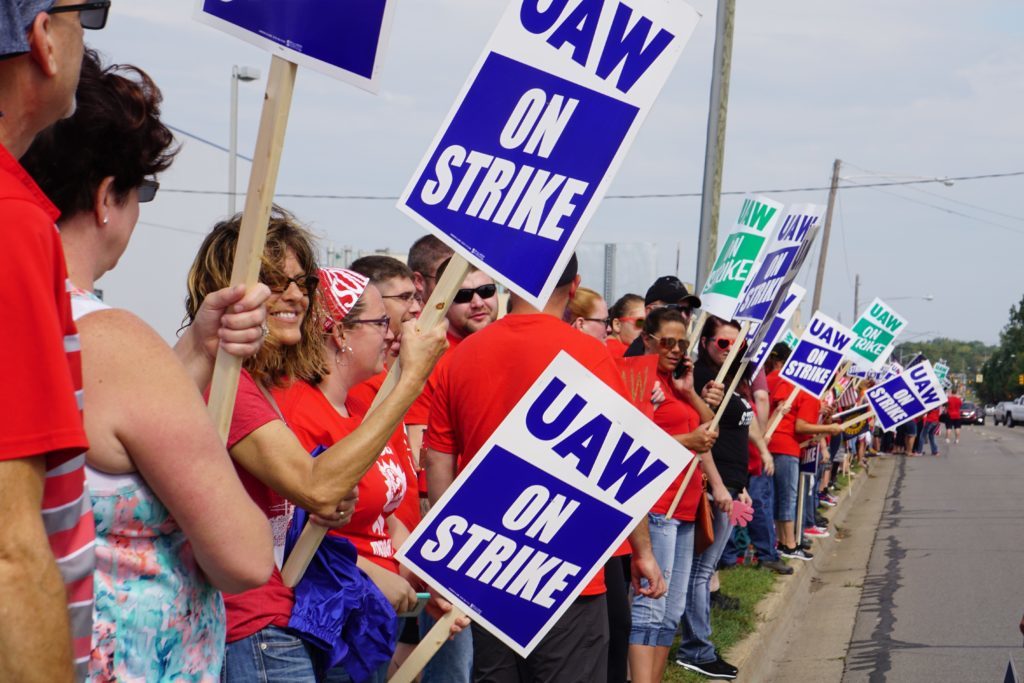

Don’t look now, but the General Motors strike is threatening to become a significant drag on a U.S. manufacturing economy that really doesn’t need any more baggage right now.
By entering its third week with the two sides declaring they’re still far apart in settling key issues, the walkout by some 46,000 full-time United Auto Workers members at GM factories already has surprised many prognosticators by persisting this long. And the strike has moved into territory that could cause significant harm not only in terms of GM’s profits, and strikers’ pay, but also in retarding the economies of key manufacturing states in the Midwest and even the U.S. economy as a whole.
The first significant UAW walkout since its last strike at GM since 2007, and the longest strike at America’s largest automaker since 1998, the work stoppage already has cost the company more than $100 million in profits to date, according to estimates by Wall Street analysts. Ripple effects have been spreading in terms of shutdowns of GM plants in Canada and Mexico because of parts shortages, idling of some production at major GM suppliers, and swelling inventories of U.S. steel and aluminum.
Both sides say the unresolved major issues include UAW demands for wage increases and enhanced profit-sharing as well as the union’s complaint about GM’s increasing use of lower-paid temporary workers.
Meanwhile, the concerns of GM CEO Mary Barra include a leveling off of U.S. auto sales and her desire to keep costs in check not only as preparation for any true automotive recession but also to keep powder dry for future investment demands in the realms of electric and autonomous vehicles.
It’s also unclear what role the UAW’s crisis in top leadership is playing, with officials including President Gary Jones under a federal corruption investigation. Having the internal credibility and trust to “sell” any tentative agreement with GM to rank-and-file workers who must ratify the pact will be a major test of Jones’ young tenure.
The overall economies of Michigan, Indiana, Ohio and other major GM manufacturing strongholds are in much better shape to weather the temporary disruptions inherent in a strike of short duration than they have been at any time in the last decade or so. But strikes can have a way of taking on lives of their own that none of the principals can foresee, both in terms of the primary players as well as the economy as a whole. And perhaps that’s what’s already happened in this case.
Read more: Rise of CEO Pay Issue Is Underscored By Unionists’ Concerns In GM Strike

0

1:00 - 5:00 pm
Over 70% of Executives Surveyed Agree: Many Strategic Planning Efforts Lack Systematic Approach Tips for Enhancing Your Strategic Planning Process
Executives expressed frustration with their current strategic planning process. Issues include:
Steve Rutan and Denise Harrison have put together an afternoon workshop that will provide the tools you need to address these concerns. They have worked with hundreds of executives to develop a systematic approach that will enable your team to make better decisions during strategic planning. Steve and Denise will walk you through exercises for prioritizing your lists and steps that will reset and reinvigorate your process. This will be a hands-on workshop that will enable you to think about your business as you use the tools that are being presented. If you are ready for a Strategic Planning tune-up, select this workshop in your registration form. The additional fee of $695 will be added to your total.

2:00 - 5:00 pm
Female leaders face the same issues all leaders do, but they often face additional challenges too. In this peer session, we will facilitate a discussion of best practices and how to overcome common barriers to help women leaders be more effective within and outside their organizations.
Limited space available.

10:30 - 5:00 pm
General’s Retreat at Hermitage Golf Course
Sponsored by UBS
General’s Retreat, built in 1986 with architect Gary Roger Baird, has been voted the “Best Golf Course in Nashville” and is a “must play” when visiting the Nashville, Tennessee area. With the beautiful setting along the Cumberland River, golfers of all capabilities will thoroughly enjoy the golf, scenery and hospitality.
The golf outing fee includes transportation to and from the hotel, greens/cart fees, use of practice facilities, and boxed lunch. The bus will leave the hotel at 10:30 am for a noon shotgun start and return to the hotel after the cocktail reception following the completion of the round.